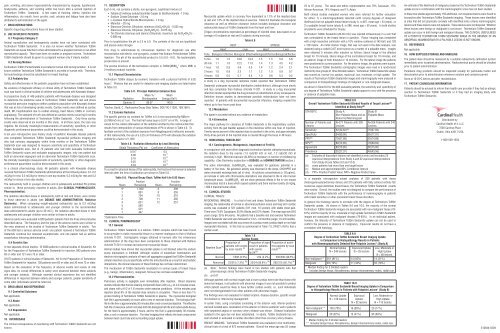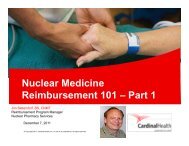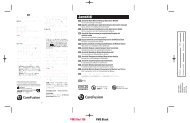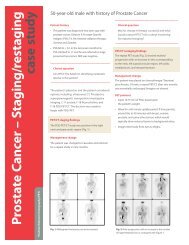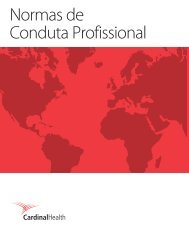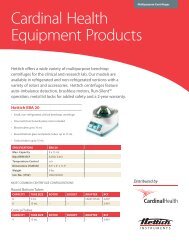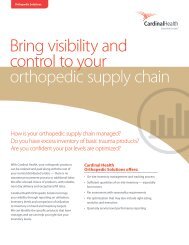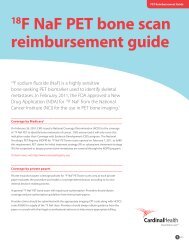FDA-approved radiopharmaceuticals - Cardinal Health
FDA-approved radiopharmaceuticals - Cardinal Health
FDA-approved radiopharmaceuticals - Cardinal Health
You also want an ePaper? Increase the reach of your titles
YUMPU automatically turns print PDFs into web optimized ePapers that Google loves.
pain, vomiting, and severe hypersensitivity characterized by dyspnea, hypotension,<br />
bradycardia, asthenia, and vomiting within two hours after a second injection of<br />
Technetium Tc99m Sestamibi. A few cases of flushing, edema, injection site<br />
inflammation, dry mouth, fever, pruritis, rash, urticaria and fatigue have also been<br />
attributed to administration of the agent.<br />
7. DRUG INTeRaCTIoNS<br />
Specific drug-drug interactions have not been studied.<br />
8. USe IN SPeCIfIC PaTIeNTS<br />
8.1 Pregnancy Category C<br />
Animal reproduction and teratogenicity studies have not been conducted with<br />
Technetium Tc99m Sestamibi. It is also not known whether Technetium Tc99m<br />
Sestamibi can cause fetal harm when administered to a pregnant woman or can affect<br />
reproductive capacity. There have been no studies in pregnant women. Technetium<br />
Tc99m Sestamibi should be given to a pregnant woman only if clearly needed.<br />
8.2 Nursing mothers<br />
Technetium Tc99m Pertechnetate is excreted in human milk during lactation. It is not<br />
known whether Technetium Tc99m Sestamibi is excreted in human milk. Therefore,<br />
formula feedings should be substituted for breast feedings.<br />
8.3 Pediatric Use<br />
Safety and effectiveness in the pediatric population have not been established.<br />
No evidence of diagnostic efficacy or clinical utility of Technetium Tc99m Sestamibi<br />
scan was found in clinical studies of children and adolescents with Kawasaki disease.<br />
A prospective study of 445 pediatric patients with Kawasaki disease was designed<br />
to determine the predictive value of Technetium Tc99m Sestamibi rest and stress<br />
myocardial perfusion imaging to define a pediatric population with Kawasaki disease<br />
that was at risk of developing cardiac events. Cardiac events were defined as cardiac<br />
death, MI, hospitalization due to cardiac etiology, heart failure, CABG or coronary<br />
angioplasty. The standard of truth was defined as cardiac events occurring 6 months<br />
following the administration of Technetium Tc99m Sestamibi . Only three cardiac<br />
events were observed at six months in this study. In all three cases, the scan was<br />
negative. No clinically meaningful measurements of sensitivity, specificity or other<br />
diagnostic performance parameters could be demonstrated in this study.<br />
A ten year retrospective case history study of pediatric Kawasaki disease patients<br />
who completed Technetium Tc99m Sestamibi myocardial perfusion imaging and<br />
who had coronary angiography within three months of the Technetium Tc99m<br />
Sestamibi scan was designed to measure sensitivity and specificity of Technetium<br />
Tc99m Sestamibi scan. Out of 72 patients who had both evaluable Technetium<br />
Tc99m Sestamibi scans and evaluable angiographic images, only one patient had<br />
both an abnormal angiogram and an abnormal Technetium Tc99m Sestamibi scan.<br />
No clinically meaningful measurements of sensitivity, specificity or other diagnostic<br />
performance parameters could be demonstrated in this study.<br />
In a clinical pharmacology study, 46 pediatric patients with Kawasaki disease<br />
received Technetium Tc99m Sestamibi administration at the following doses: 0.1-0.2<br />
mCi/kg for rest, 0.3 mCi/kg for stress in one day studies; 0.2 mCi/kg for rest and 0.2<br />
mCi/kg for stress in two day studies.<br />
The radioactivity both in younger children and in adolescents exhibited PK profiles<br />
similar to those previously reported in adults (See CLINICaL PhaRmaCoLoGY,<br />
Pharmacokinetics).<br />
The radiation absorbed doses in adolescents, both at rest and stress, were similar<br />
to those observed in adults (see DoSaGe aND aDmINISTRaTIoN, Radiation<br />
Dosimetry). When comparing weight-adjusted radioactivity (up to 0.3 mCi/kg)<br />
doses administered to adolescents and younger children to the recommended<br />
dose administered to adults (up to 30 mCi ), the radiation absorbed doses in both<br />
adolescents and younger children were similar to those in adults.<br />
Adverse events were evaluated in 609 pediatric patients from the three clinical studies<br />
described above. The frequency and the type of the adverse events were similar to<br />
the ones observed in the studies of Technetium Tc99m Sestamibi in adults. Two<br />
of the 609 had a serious adverse event: one patient received a Technetium Tc99m<br />
Sestamibi overdose but remained asymptomatic, and one patient had an asthma<br />
exacerbation following administration.<br />
8.4 Geriatric Use<br />
In two separate clinical studies: Of 3068 patients in clinical studies of Sestamibi, Kit<br />
for the Preparation of Technetium Tc99m Sestamibi for Injection, 693 patients were<br />
65 or older and 121 were 75 or older.<br />
Of 673 patients in clinical studies of Sestamibi, Kit for the Preparation of Technetium<br />
Tc99m Sestamibi for Injection, 138 patients were 65 or older and 30 were 75 or older.<br />
Based on the evaluation of the frequency of adverse events and review of vital<br />
signs data, no overall differences in safety were observed between these subjects<br />
and younger subjects. Although reported clinical experience has not identified<br />
differences in response between elderly and younger patients, greater sensitivity of<br />
some older individuals cannot be ruled out.<br />
9. DRUG aBUSe aND DePeNDeNCe<br />
9.1 Controlled Substance<br />
Not applicable.<br />
9.2 abuse<br />
Not applicable.<br />
9.3 Dependence<br />
Not applicable.<br />
10. oVeRDoSaGe<br />
The clinical consequences of overdosing with Technetium Tc99m Sestamibi are not<br />
known.<br />
11. DeSCRIPTIoN<br />
Each 5 mL vial contains a sterile, non-pyrogenic, lyophilized mixture of:<br />
• Tetrakis (2-methoxy isobutyl isonitrile) Copper (I) tetrafluoroborate - 1.0 mg<br />
• Sodium Citrate Dihydrate - 2.6 mg<br />
• L-Cysteine Hydrochloride Monohydrate - 1.0 mg<br />
• Mannitol – 20 mg<br />
• Stannous Chloride, Dihydrate, minimum (SnCl2•2H2O) - 0.025 mg<br />
• Stannous Chloride, Dihydrate, (SnCl2•2H2O) - 0.075 mg<br />
• Tin Chloride (stannous and stannic) Dihydrate, maximum (as SnCl2•2H2O) -<br />
0.086 mg<br />
Prior to lyophilization the pH is 5.3 to 5.9. The contents of the vial are lyophilized<br />
and stored under nitrogen.<br />
This drug is administered by intravenous injection for diagnostic use after<br />
reconstitution with sterile, non-pyrogenic, oxidant-free Sodium Pertechnetate Tc99m<br />
Injection. The pH of the reconstituted product is 5.5 (5.0 - 6.0). No bacteriostatic<br />
preservative is present.<br />
+<br />
The precise structure of the technetium complex is Tc99m[MIBI] where MIBI is<br />
6<br />
2-methoxy isobutyl isonitrile.<br />
11.1 Physical Characteristics<br />
Technetium Tc99m decays by isomeric transition with a physical half-life of 6.02<br />
hours 1 . Photons that are useful for detection and imaging studies are listed below<br />
in Table 3.0.<br />
Table 3.0. Principal Radiation emission Data<br />
Mean %/ Mean<br />
Radiation Disintegration Energy (KeV)<br />
Gamma -2 89.07 140.5<br />
1<br />
Kocher, David, C., Radioactive Decay Data Tables, DOE/TIC-11026, 108(1981).<br />
11.2 external Radiation<br />
The specific gamma ray constant for Tc99m is 5.4 microcoulombs/Kg-MBq-hr<br />
(0.78R/mCi-hr) at 1 cm. The first half value layer is 0.017 cm of Pb. A range of<br />
values for the relative attenuation of the radiation emitted by this radionuclide that<br />
results from interposition of various thicknesses of Pb is shown in Table 4.0. To<br />
facilitate control of the radiation exposure from Megabequerel (millicurie) amounts<br />
of this radionuclide, the use of a 0.25 cm thickness of Pb will attenuate the radiation<br />
emitted by a factor of 1,000.<br />
Table 4.0. Radiation attenuation by Lead Shielding<br />
Shield Thickness (Pb) cm Coefficient of Attenuation<br />
0.017 0.5<br />
0.08 10 -1<br />
0.16 10 -2<br />
0.25 10 -3<br />
0.33 10 -4<br />
To correct for physical decay of this radionuclide, the fractions that remain at selected<br />
intervals after the time of calibration are shown in Table 5.0.<br />
Table 5.0. Physical Decay Chart; Tc99m half-Life 6.02 hours<br />
Fraction Fraction<br />
Hours Remaining Hours Remaining<br />
0* 1.000 8 .398<br />
1 .891 9 .355<br />
2 .794 10 .316<br />
3 .708 11 .282<br />
4 .631 12 .251<br />
5 .562<br />
6 .501<br />
7 .447<br />
*Calibration Time<br />
12. CLINICaL PhaRmaCoLoGY<br />
12.1 General<br />
Technetium Tc99m Sestamibi is a cationic Tc99m complex which has been found<br />
to accumulate in viable myocardial tissue in a manner analogous to that of thallous<br />
chloride Tl-201. Scintigraphic images obtained in humans after the intravenous<br />
administration of the drug have been comparable to those obtained with thallous<br />
chloride Tl-201 in normal and abnormal myocardial tissue.<br />
Animal studies have shown that myocardial uptake is not blocked when the sodium<br />
pump mechanism is inhibited. Although studies of subcellular fractionation and<br />
electron micrographic analysis of heart cell aggregates suggest that Tc99m Sestamibi<br />
cellular retention occurs specifically within the mitochondria as a result of electrostatic<br />
interactions, the clinical relevance of these findings has not been determined.<br />
The mechanism of Tc99m Sestamibi localization in various types of breast tissue<br />
(e.g., benign, inflammatory, malignant, fibrous) has not been established.<br />
12.2 Pharmacokinetics<br />
Pulmonary activity is negligible even immediately after injection. Blood clearance<br />
studies indicate that the fast clearing component clears with a t1/2 of 4.3 minutes at rest,<br />
and clears with a t1/2 of 1.6 minutes under exercise conditions. At five minutes post<br />
injection about 8% of the injected dose remains in circulation. There is less than 1%<br />
protein binding of Technetium Tc99m Sestamibi in plasma. The myocardial biological<br />
half-life is approximately six hours after a rest or exercise injection. The biological halflife<br />
for the liver is approximately 30 minutes after a rest or exercise injection. The effective<br />
half-life of clearance (which includes both the biological half-life and radionuclide decay)<br />
for the heart is approximately 3 hours, and for the liver is approximately 30 minutes,<br />
after a rest or exercise injection. The ideal imaging time reflects the best compromise<br />
between heart count rate and surrounding organ uptake.<br />
3722<br />
3722<br />
Myocardial uptake which is coronary flow dependent is 1.2% of the injected dose<br />
at rest and 1.5% of the injected dose at exercise. Table 6.0 illustrates the biological<br />
clearance as well as effective clearance (which includes biological clearance and<br />
radionuclide decay) of Tc99m Sestamibi from the heart and liver.<br />
[Organ concentrations expressed as percentage of injected dose; data based on an<br />
average of 5 subjects at rest and 5 subjects during exercise].<br />
Table 6.0<br />
REST STRESS<br />
Heart Liver Heart Liver<br />
Time Biological Effective Biological Effective Biological Effective Biological Effective<br />
5 min. 1.2 1.2 19.6 19.4 1.5 1.5 5.9 5.8<br />
30 min. 1.1 1.0 12.2 11.5 1.4 1.3 4.5 4.2<br />
1 hour 1.0 0.9 5.6 5.0 1.4 1.2 2.4 2.1<br />
2 hours 1.0 0.8 2.2 1.7 1.2 1.0 0.9 0.7<br />
4 hours 0.8 0.5 0.7 0.4 1.0 0.6 0.3 0.2<br />
A study in a dog myocardial ischemia model reported that Technetium Tc99m<br />
Sestamibi undergoes myocardial distribution (redistribution), although more slowly<br />
and less completely than thallous chloride Tl-201. A study in a dog myocardial<br />
infarction model reported that the drug showed no redistribution of any consequence.<br />
Definitive human studies to demonstrate possible redistribution have not been<br />
reported. In patients with documented myocardial infarction, imaging revealed the<br />
infarct up to four hours post dose.<br />
12.3 metabolism<br />
The agent is excreted without any evidence of metabolism.<br />
12.4 elimination<br />
The major pathway for clearance of Tc99m Sestamibi is the hepatobiliary system.<br />
Activity from the gall bladder appears in the intestines within one hour of injection.<br />
Twenty-seven percent of the injected dose is excreted in the urine, and approximately<br />
thirty-three percent of the injected dose is cleared through the feces in 48 hours.<br />
13. NoNCLINICaL ToxICoLoGY<br />
13.1 Carcinogenesis, mutagenesis, Impairment of fertility<br />
In comparison with most other diagnostic technetium labeled <strong>radiopharmaceuticals</strong>,<br />
the radiation dose to the ovaries (1.5 rads/30 mCi at rest, 1.2 rads/30 mCi at<br />
exercise) is high. Minimal exposure (ALARA) is necessary in women of childbearing<br />
capability. (See Dosimetry subsection in DoSaGe and aDmINISTRaTIoN section.)<br />
The active intermediate, Cu(MIBI) 4BF4 , was evaluated for genotoxic potential in a<br />
battery of five tests. No genotoxic activity was observed in the Ames, CHO/HPRT and<br />
sister chromatid exchange tests (all in vitro). At cytotoxic concentrations (> 20 µg/mL),<br />
an increase in cells with chromosome aberrations was observed in the in vitro human<br />
lymphocyte assay. Cu(MIBI) 4BF4 did not show genotoxic effects in the in vivo mouse<br />
micronucleus test at a dose which caused systemic and bone marrow toxicity (9 mg/kg,<br />
> 600 X maximal human dose).<br />
14. CLINICaL STUDIeS<br />
CLINICAL TRIALS:<br />
MYOCARDIAL IMAGING: : In a trial of rest and stress Technetium Tc99m Sestamibi<br />
imaging, the relationship of normal or abnormal perfusion scans and long term cardiac<br />
events was evaluated in 521 patients (511 men, 10 women) with stable chest pain.<br />
There were 73.9% Caucasians, 25.9% Blacks and 0.2% Asians. The mean age was 59.6<br />
years (range: 29 to 84 years). All patients had a baseline rest and exercise Technetium<br />
Tc99m Sestamibi scan and were followed for 13.2 + 4.9 months (range: 1 to 24 months).<br />
Images were correlated with the occurrence of a cardiac event (cardiac death or non-fatal<br />
myocardial infarction). In this trial as summarized in Table 7.0, 24/521 (4.6%) had a<br />
cardiac event.<br />
Table 7.0<br />
Cardiac events<br />
Baseline Scan (a)<br />
Proportion of<br />
patients with events<br />
by scan results (a)<br />
Proportion of scan<br />
result in patients<br />
with events;<br />
N=24 (a)<br />
Proportion of eventfree<br />
patients by scan<br />
result (a)<br />
Normal 1/206 (0.5%) 1/24 (4.2%) 205/206 (99.5%)<br />
Abnormal 23/315 (7.3%) (b)<br />
23/24 (95.8%) (b)<br />
292/315 (92.7%) (b)<br />
(a) Note: Similar findings were found in two studies with patients who had<br />
pharmacologic stress Technetium Tc99m Sestamibi imaging.<br />
(b) p


